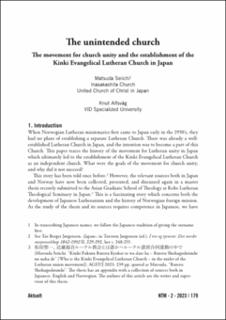| dc.contributor.author | Matsuda, Seiich | |
| dc.contributor.author | Alfsvåg, Knut | |
| dc.date.accessioned | 2024-01-19T08:52:42Z | |
| dc.date.available | 2024-01-19T08:52:42Z | |
| dc.date.created | 2023-12-30T15:50:17Z | |
| dc.date.issued | 2023 | |
| dc.identifier.citation | Norsk tidsskrift for misjonsvitenskap. 2023, 77 (2), 179-186. | en_US |
| dc.identifier.issn | 1504-6605 | |
| dc.identifier.uri | https://hdl.handle.net/11250/3112691 | |
| dc.description | Dette verket er lisensiert under Creative Commons Attribution-NonCommercial-NoDerivatives 4.0 International License.
Norsk Tidsskrift for Misjonsvitenskap er i dag et digitalt tidsskrift som er tilgjengelig gratis for alle. Artikler gjøres offentlig tilgjengelige med en såkaldt Creative Commons lisens CC BY-ND på tidsskriftets hjemmeside. Dette innebærer at alle står fritt til å gjenbruke artikkelen under forutsetning av at opphavspersonen blir navngitt. | en_US |
| dc.description.abstract | When Norwegian Lutheran missionaries first came to Japan early in the 1950’s, they had no plans of establishing a separate Lutheran Church. There was already a well-established Lutheran Church in Japan, and the intention was to become a part of this Church. This paper traces the history of the movement for Lutheran unity in Japan which ultimately led to the establishment of the Kinki Evangelical Lutheran Church as an independent church. What were the goals of the movement for church unity, and why did it not succeed? This story has been told once before.2 However, the relevant sources both in Japan and Norway have now been collected, presented, and discussed again in a master thesis recently submitted to the Asian Graduate School of Theology at Kobe Lutheran Theological Seminary in Japan.3This is a fascinating story which concerns both the development of Japanese Lutheranism and the history of Norwegian foreign mission. As the study of the thesis and its sources requires competence in Japanese, we have decided to make its main findings more easily accessible through this article.
1In transcribing Japanese names, we follow the Japanese tradition of giving the surname first.
2 See Tor Berger Jørgensen, «Japan», in Torstein Jørgensen (ed.), I tro og tjeneste: Det norske misjonsselskap 1842-1992 II, 229-292, her s. 248-255.
3 松田聖一、近畿福音ルーテル教会とは誰か~ルーテル諸派合同運動の中で(Matsuda Seiichi, “Kinki Fukuin Ruteru Kyokai to wa dare ka – Ruteru Shohagodoundo no naka de” [Who is the Kinki Evangelical Lutheran Church – in the midst of the Lutheran union movement]), AGST/J 2023, 239 pp, quoted as Matsuda, “Ruteru Shohagodoundo”. The thesis has an appendix with a collection of sources both in Japanese, English and Norwegian. The authors of this article are the writer and super-visor of this thesis. | en_US |
| dc.language.iso | eng | en_US |
| dc.publisher | MF vitenskapelig høyskole | en_US |
| dc.relation.uri | https://journals.mf.no/ntm/article/view/5558/4560 | |
| dc.rights | Attribution-NonCommercial-NoDerivatives 4.0 Internasjonal | * |
| dc.rights.uri | http://creativecommons.org/licenses/by-nc-nd/4.0/deed.no | * |
| dc.subject | Kinki Evangelical Lutheran Church | en_US |
| dc.subject | Japan | en_US |
| dc.subject | church unity | en_US |
| dc.title | The unintended church: The movement for church unity and the establishment of the Kinki Evangelical Lutheran Church in Japan | en_US |
| dc.type | Peer reviewed | en_US |
| dc.type | Journal article | en_US |
| dc.description.version | publishedVersion | en_US |
| dc.rights.holder | Opphavsrett 2023 Norsk tidsskrift for misjonsvitenskap | en_US |
| dc.source.pagenumber | 179-186 | en_US |
| dc.source.volume | 77 | en_US |
| dc.source.journal | Norsk tidsskrift for misjonsvitenskap | en_US |
| dc.source.issue | 2 | en_US |
| dc.identifier.doi | 10.48626/ntm.v77i2.5558 | |
| dc.identifier.cristin | 2218203 | |
| cristin.ispublished | true | |
| cristin.fulltext | original | |
| cristin.qualitycode | 1 | |

